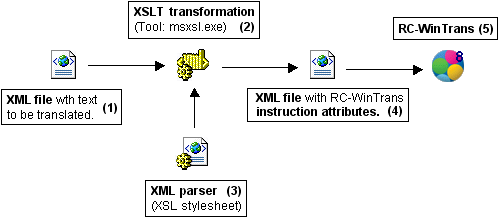|
^ Top
^
|

|
XSL Transformation Stylesheet |
|
Using an XSLT Stylesheet as an XML Parser –
BaSiC Concepts
|
1. |
The
is used to
those
in an XML document that are translatable ().
|
|
2. |
An
is
to the selected
to specify that the text of an element (or of an attribute) is translatable
(). |
The XSL programming is done in an XSL
stylesheet (file extension = .xsl). This
stylesheet is what is known as the ""
(. |
The XSL stylesheet acts as an XML parser
and is used as input for an
to create an XML file with additional attributes specifying that elements
and/or attributes are translatable.
There are two tasks which the XSL file must
describe:
|
1. |
copy elements –
make a copy of the XML file (the XML
file to be translated). |
|
2. |
add
– specify
those XML elements and attributes that are translatable by adding instruction
attributes. |
A set of RC-WinTrans
XML attributes are provided to specify that an element or attribute is
translatable. These attributes are added to an XML element, giving instructions
on what is to be done with that element. They
are called ""
because they give RC-WinTrans instructions for handling the element.
Please refer to the "RC-WinTrans
Instruction Attributes" topic for additional details.
To create your own ,
use the XSL template file provided with
RC-WinTrans ("XMLParser-Template.XSL"; directory: "Samples"
| "Developing" | "XML Parser").
See also: "XML Examples: Overview."
^ Top ^
|

|
How to Create an XML Parser |
|
1. |
Make a copy of the XML
parser template file. |
|
2. |
Ascertain the name of the
of the specific XML file structure supported by the parser. |
|
3. |
Edit the XSL file, using the
to specify all translatable elements. |
|
4. |
Use the name of the root element (Step 2)
to rename the template file following the naming convention for RC-WinTrans
files: "XMLParser-<root element name>.XSL" |
|

|
Unique Identification of Elements |
The
elements of an XML file to be translated should be positively identifiable
so that RC-WinTrans can accurately update the database whenever changes
are made to the (source) XML file and existing translation data will be
preserved during the update.
Giving an element an identifier
()
that is unique within the XML file guarantees positive identification
of that element. If
an element is a child element of a group, its identifier (ID) should be
unique within the parent group. The
group must therefore have a
too.
Specifying a Resource Name
The identifier (resource
name) of the three
("rwt:group,"
"rwt:elementTU,"
and "rwt:attributeTU_<attrName>") is specified with the respective
element's value (element text).
NOTE: The resource names
of groups and elements do not have to be unique- this is not a requirement
for the file. It
is, however, required in order to preserve existing translation data during
the update database process, which updates the source information whenever
changes have been made to the original (source) XML file.
^ Top ^
|

|
Testing an XML Parser |
|
1. |
Copy the following files into one folder:
|
· |
|
|
· |
your
(file extension = .xsl) |
|
· |
one of the
files for which your XML parser was created. |
|
|
2. |
Run ""
to generate a copy of the XML file that should contain the RC-WinTrans
instruction attributes for all elements that need to be
translated.
|
|
3. |
Check the XML file that was
created.
|
|
4. |
Once the transformed
file has been created you can add your XML file to be translated to an
RC-WinTrans project. The
elements to be translated should be displayed in RC-WinTrans' Project
window.
If the elements are not read and listed as
expected, you will need to edit the parser again. Once
this is done you can force RC-WinTrans to reread the XML file by performing
the following actions:
|
a. |
Open the Source
and Target Files dialog box. |
|
b. |
Select the XML file in the display on the
Source Files page. |
|
c. |
Check the Force
update for unchanged source files checkbox at the bottom of the
page. |
|
d. |
Press the Update
(selected) button. |
|
^ Top ^
|

|
XML Parser File Naming Convention |
(file extension =.xsl) have a predefined file naming convention. It
dictates that the file name begin with the prefix "XMLParser-"
followed
by the name of the
of the XML file for which the parser is made.
EXAMPLE: "XMLParser-.xsl";
"XMLParser-docroot.xsl"
NOTE: If
the name of the
contains a namespace then an underline character must be used in the file
name for the ':' between the namespace and the root element name
EXAMPLE: root
element name <mnts:materials>
XML
parser file name "XMLParser-mnts_materials"
|

|
Activating the XML Parser File |
Option 1: Local
Folder
Place the
in the same folder as the XML files to be translated. This
causes the XML parser to be used only on XML files located in the same
folder.
If you're developing an XML parser, the parser
file and an XML file (to be translated) will be in one folder. The XML
file can be directly added to an RC-WinTrans project. RC-WinTrans
will automatically use the XML parser if the parser file meets the predefined
file naming convention (see above).
Option
2: General
File Converters Folder
Place the
in the RC-WinTrans installation folder named "FileConverters"
(<installdir>\RC-WinTrans 9\FileConverters). This
causes the XML parser to be used globally for all XML files (supplied
by a particular XML parser file).
RC-WinTrans will look for the XML parser
file in the same folder as the one containing the XML file to be translated
(local folder) first. If
a converter is not found there, RC-WinTrans will check the "FileConverter"
folder for the required XML parser (general file converters folder).
^ Top ^ | 
